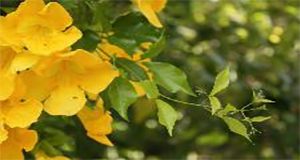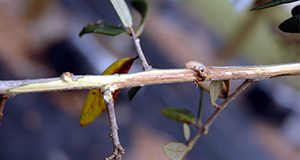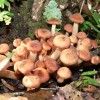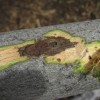Species in the Laetiporus sulphureus species complex, also known as “chicken of the woods” mushrooms, are wood-decay fungi that cause brown rot within the heartwood of their tree hosts. The common name “chicken of the woods” is given to some species in this group because they are tasty edible mushrooms. Several Laetiporus species have been harvested to use as food colorants, to dye natural products such as wool, and for human consumption. This new 4-page publication of the UF/IFAS Plant Pathology Department, written by Brianna Benitez, Claudia A. Paez, Matthew E. Smith, and Jason A. Smith, describes these fungi as well as their ecology, management, and potential edibility.
https://edis.ifas.ufl.edu/pp358
Tag: Jason A. Smith
Cat’s-Claw Vine, Dolichandra unguis-cati : A Showy but Invasive Plant in Florida

Cat’s-claw vine is a neotropical, climbing perennial that produces large and showy yellow flowers in the springtime. Unfortunately, the aggressive nature of the vine has made it a major weed in China, Australia, South Africa, and parts of the southeastern United States. This 6-page fact sheet written by Niels Proctor and Jason Smith and published by the UF/IFAS School of Forest Resources and Conservation provides guidance on identification and control of this invasive vine and suggests some similar native vines to use instead.
http://edis.ifas.ufl.edu/fr391
Metsulfuron-Methyl-Containing Herbicides Potentially Damaging Ornamentals when Applied to Turfgrass

Metsulfuron-methyl, also known as MSM, is an herbicide that is used to control broadleaf weeds and certain grass weeds. It provides effective control of some of the most problematic turfgrass weeds, such as wild garlic, Florida betony, dollar weed, and small Virginia buttonweed. Metsulfuron-methyl is absorbed by plant foliage, so if landscape plants come into contact with the spray or drift they can be injured. This four-page fact sheet describes the potential problems with metsulfuron herbicides, the areas most subsceptible to damage, how to diagnose injury, and how to reduce damage. Written by Chris Marble, Jason Smith, Timothy K. Broschat, Adam Black, Ed Gilman, and Celeste White and published by the School of Forest Resources and Conservation Department.
http://edis.ifas.ufl.edu/fr400
Bot Canker of Oak in Florida Caused by Diplodia corticola and D. quercivora
 This 6-page fact sheet describes the emergence of these two pathogens of oak and grapevine in North America and Florida; the signs and symptoms of infection; mechanism of host disease and death; fungal morphology; origin, host range, and classification; and management options. Written by Sonja Mullerin and Jason A. Smith, and published by the UF Department of School of Forest Resources and Conservation, March 2015. (Photo: Jason Smith, UF/IFAS)
This 6-page fact sheet describes the emergence of these two pathogens of oak and grapevine in North America and Florida; the signs and symptoms of infection; mechanism of host disease and death; fungal morphology; origin, host range, and classification; and management options. Written by Sonja Mullerin and Jason A. Smith, and published by the UF Department of School of Forest Resources and Conservation, March 2015. (Photo: Jason Smith, UF/IFAS)
http://edis.ifas.ufl.edu/fr386
Armillaria Root Rot (Also known as Mushroom Root Rot, Shoestring Root Rot, Honey Mushroom Rot)
 Armillaria root rot is a disease that decays the root system of many common trees and shrubs. It is caused by several species of Armillaria, fungi that can be recognized by the clusters of yellow to honey-colored mushrooms that emerge during moist conditions. The disease is often lethal, and infected trees may have wilting branches, branch dieback, and stunted growth. Infected trees and shrubs should be removed and replaced with resistant species. This 4-page fact sheet was written by Laura Sanagorski, Aaron Trulock, and Jason Smith, and published by the UF Department of Environmental Horticulture, July 2013.
Armillaria root rot is a disease that decays the root system of many common trees and shrubs. It is caused by several species of Armillaria, fungi that can be recognized by the clusters of yellow to honey-colored mushrooms that emerge during moist conditions. The disease is often lethal, and infected trees may have wilting branches, branch dieback, and stunted growth. Infected trees and shrubs should be removed and replaced with resistant species. This 4-page fact sheet was written by Laura Sanagorski, Aaron Trulock, and Jason Smith, and published by the UF Department of Environmental Horticulture, July 2013.
http://edis.ifas.ufl.edu/ep478
Thousand Cankers Disease: A Threat to Black Walnut in Florida (FOR308/FR376)
 Thousand cankers disease of walnut is a tree disease of the edible nut-producing and ornamental tree, black walnut. The first diseased trees were observed in New Mexico in the 1990s. The disease has since spread to most of the western states. Until 2009, diseased black walnut trees were only found outside of the natural range of black walnut, which occurs from the mid-Atlantic states to just west of the Mississippi River. In 2009, it was found near Knoxville, Tennessee; it has since spread to Pennsylvania and Virginia. It is possible that within the next decade this disease could naturally spread to Florida. However, if people continue to move TCD infested walnut logs from place to place, this disease could arrive in Florida tomorrow. This 3-page fact sheet was written by Don Spence and Jason A. Smith, and published by the UF Department of School of Forest Resources and Conservation, February 2013.
Thousand cankers disease of walnut is a tree disease of the edible nut-producing and ornamental tree, black walnut. The first diseased trees were observed in New Mexico in the 1990s. The disease has since spread to most of the western states. Until 2009, diseased black walnut trees were only found outside of the natural range of black walnut, which occurs from the mid-Atlantic states to just west of the Mississippi River. In 2009, it was found near Knoxville, Tennessee; it has since spread to Pennsylvania and Virginia. It is possible that within the next decade this disease could naturally spread to Florida. However, if people continue to move TCD infested walnut logs from place to place, this disease could arrive in Florida tomorrow. This 3-page fact sheet was written by Don Spence and Jason A. Smith, and published by the UF Department of School of Forest Resources and Conservation, February 2013.
http://edis.ifas.ufl.edu/fr376
Beyond the Trees: A Systems Approach to Understanding Forest Health in the Southeastern United States (FOR287/FR355)
 Forest health is an important topic for biology, agriculture, current issues, and environmental science classes. But conversations with educators suggested that they were not equipped to teach about it given their existing curricula. This 79-page educator guide includes six activities designed to help learners consider forest health from various viewpoints; understand interrelationships and feedback mechanisms in a forest system; visualize spatial and temporal mechanisms of forest system functions; appreciate the variety of threats to forest health; and consider their role as future forest stewards. Written by Geetha S. Iyer, Martha M. Monroe and Jason A. Smith, and published by the UF Department of School of Forest Resources and Conservation, July 2011.
Forest health is an important topic for biology, agriculture, current issues, and environmental science classes. But conversations with educators suggested that they were not equipped to teach about it given their existing curricula. This 79-page educator guide includes six activities designed to help learners consider forest health from various viewpoints; understand interrelationships and feedback mechanisms in a forest system; visualize spatial and temporal mechanisms of forest system functions; appreciate the variety of threats to forest health; and consider their role as future forest stewards. Written by Geetha S. Iyer, Martha M. Monroe and Jason A. Smith, and published by the UF Department of School of Forest Resources and Conservation, July 2011.
http://edis.ifas.ufl.edu/fr355
What Is a Healthy Forest? A Supplement to Florida Project Learning Tree (FOR286/FR354)
 There is no question that forests provide important ecological services and economic resources to Floridians. Similarly, there is no doubt that the health of our forests is at the mercy of how we manage our landscape and make decisions.The activities in this supplement, with the original PLT Guide, help our students rise to these twin challenges.This 84-page handbook was written by Sarah L. Hicks, Martha C. Monroe, Geetha S. Iyer, and Jason A. Smith, and published by the UF Department of School of Forest Resources and Conservation, July 2011.
There is no question that forests provide important ecological services and economic resources to Floridians. Similarly, there is no doubt that the health of our forests is at the mercy of how we manage our landscape and make decisions.The activities in this supplement, with the original PLT Guide, help our students rise to these twin challenges.This 84-page handbook was written by Sarah L. Hicks, Martha C. Monroe, Geetha S. Iyer, and Jason A. Smith, and published by the UF Department of School of Forest Resources and Conservation, July 2011.
http://edis.ifas.ufl.edu/fr354
Assessing the Survival of the Redbay Ambrosia Beetle and Laurel Wilt Pathogen in Wood Chips (FOR289/FR351)
 What is the best way for homeowners to dispose of dead redbay trees to avoid spreading laurel wilt? This 4-page fact sheet summarizes a UF/IFAS study providing evidence that a simple technique — chipping the dead trees — can help contain the disease within a small area and that there is a low probability of long-distance movement of LW via wood chips. Written by Don Spence, Jason Smith, Albert Mayfield III, Jiri Huler, Randy Ploetz and Lukasz Stelinski, and published by the UF Department of School of Forest Resources and Conservation, November 2011.
What is the best way for homeowners to dispose of dead redbay trees to avoid spreading laurel wilt? This 4-page fact sheet summarizes a UF/IFAS study providing evidence that a simple technique — chipping the dead trees — can help contain the disease within a small area and that there is a low probability of long-distance movement of LW via wood chips. Written by Don Spence, Jason Smith, Albert Mayfield III, Jiri Huler, Randy Ploetz and Lukasz Stelinski, and published by the UF Department of School of Forest Resources and Conservation, November 2011.
http://edis.ifas.ufl.edu/fr351
Emerald Ash Borer: A Potential Future Threat to Ash Trees in Florida (FOR284/FR346)
 Do not move firewood into or around the state! This invasive exotic beetle kills ash trees and is likely to reach Florida in the years to come — or faster if it gets transported by humans. Learn more in this 5-page fact sheet was written by Don Spence and Jason Smith, and published by the UF Department of School of Forest Resources and Conservation, August 2011.
Do not move firewood into or around the state! This invasive exotic beetle kills ash trees and is likely to reach Florida in the years to come — or faster if it gets transported by humans. Learn more in this 5-page fact sheet was written by Don Spence and Jason Smith, and published by the UF Department of School of Forest Resources and Conservation, August 2011.
http://edis.ifas.ufl.edu/fr346
Seiridium Canker of Leyland Cypress (FOR279/FR341)
Seiridium canker, or Cypress canker, was first reported in California in the late 1920s and has since spread throughout North America and into Florida wherever Cupressaceae (cypress family) grow. Leyland cypress can be killed or severely disfigured by the disease. This 4-page fact sheet describes the causal agent, host range, symptoms and signs, disease cycle and management, and recommends tree replacements with resistance to Seiridium canker. Written by Jason A. Smith, and published by the UF Department of School of Forest Resources and Conservation, November 2010.
http://edis.ifas.ufl.edu/fr341
FOR276/FR338 The Decline of Florida Torreya: An Endemic Conifer on the Edge of Extinction
FOR276, a 5-page fact sheet by Jason A. Smith and Aaron Trulock, suggests a new understanding of the cause of decline and discusses current efforts to assess the population and develop a recovery plan. Includes references. Published by the UF Department of School of Forest Resources and Conservation, November 2010.
http://edis.ifas.ufl.edu/fr338
FOR274/FR336 Oak Wilt: A Potential Future Threat to Oaks in Florida
FOR274, a 5-page fact sheet by Kelly Peacock and Jason Smith, provides information on the diagnosis, biology, and management of the disease and should provide guidance for future efforts to identify and manage oak wilt in the state of Florida. Includes references. Published by the UF Department of School of Forest Resources and Conservation, November 2010.
http://edis.ifas.ufl.edu/fr336
FOR236/FR298 Pitch Canker Disease of Pines
FOR236, a 4-page illustrated page fact sheet by Tyler Dreaden and Jason Smith, describes this disease of conifers caused by the fungus Fusarium circinatum — Symptoms and Signs, Disease Biology, Geographical Distribution and Management. Includes references. Published by the UF School of Forest Resources and Conservation, May 2010.
http://edis.ifas.ufl.edu/fr298
HS1179 Homeowner Detection of and Recommendations for Mitigating Redbay Ambrosia Beetle-Laurel Wilt Disease on Redbay and Avocado Trees in the Home Landscape
HS1179, a 4-page illustrated fact sheet by Jonathan H. Crane and Jason A. Smith, provides homeowners with an update on redbay ambrosia beetle-laurel wilt disease in Florida, how the beetle and pathogen are spread, symptoms of infestations, and recommendations for homeowners. Includes references. Published by the UF Department of Horticultural Sciences, May 2010.
http://edis.ifas.ufl.edu/hs1179
HS1137/HS391 Laurel Wilt: A Threat to Redbay, Avocado and Related Trees in Urban and Rural Landscapes
HS-1137, a 6-page illustrated fact sheet by Albert E. Mayfield III, Jonathan H. Crane and Jason A. Smith, describes for homeowners this fungal disease of trees in the laurel family that is carried by the non-native redbay ambrosia beetle. Includes descriptions of the beetles, plant hosts, impact, host symptoms, and management strategies. Includes references. Published by the UF Horticultural Sciences Department, March 2008.
http://edis.ifas.ufl.edu/HS391
